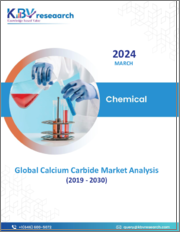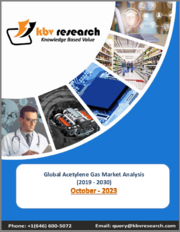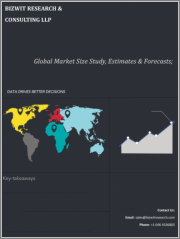
|
시장보고서
상품코드
1468552
아세틸렌 가스 시장 보고서 : 제조 방법, 용도 및 지역별(2024-2032년)Acetylene Gas Market Report by Production Method (Calcium Carbide, Hydrocarbon Pyrolysis), Application (Chemical Synthesis, Welding and Cutting, Metal Fabrication, and Others), and Region 2024-2032 |
||||||
2023년 아세틸렌 가스 세계 시장 규모는 60억 달러에 달했습니다. IMARC 그룹은 2032년까지 시장 규모가 75억 달러에 달하고 2024-2032년 연평균 성장률(CAGR)이 2.4%를 나타낼 것으로 예측했습니다.
아세틸렌은 무색의 가연성 가스로 탄산칼슘과 물의 조합으로 생성됩니다. 석탄, 원유, 나프타 등 탄화수소를 사용하여 생산할 수 있으며, 액화, 압축, 가열, 공기와의 혼합을 통해 폭발성이 높아집니다. 이 가스는 화학물질 제조 및 금속 가공에서 절단 및 용접의 중간체로 가장 일반적으로 사용됩니다. 또한 상업용 건전지 및 아세틸 알코올 제조에도 사용되며 화학, 자동차, 운송, 항공우주, 제약 등 다양한 산업에서 광범위하게 사용되고 있습니다.
이 시장은 주로 세계의 급속한 산업화에 따른 화학 산업의 급속한 성장에 의해 주도되고 있습니다. 아세틸렌 가스는 높은 연소 온도 특성으로 인해 옥시 아세틸렌 절단, 열처리, 납땜, 브레이징, 용접 등 다양한 금속 가공 응용 분야에 널리 사용되고 있습니다. 기존 산소 기반 연료와 비교하여 옥시 아세틸렌을 함께 사용하면 더 빠른 피어싱과 예열이 가능합니다. 이로 인해 절단 품질, 절단 속도, 절단 시작 시간이 개선되어 효율성이 향상되어 모든 산업 분야에서 널리 사용되고 있습니다. 또한 아세틸렌 가스는 무수 아세트산, 아세트산, 아세트알데히드 등 다양한 화학 물질의 합성에도 사용됩니다. 이 외에도 아세틸렌 가스는 유리 산업 및 재료 가공 산업에서 재료 표면 사이의 윤활을 돕는 탄소 코팅에 사용됩니다. 바이오가스 및 기타 바이오연료에서 가스를 생산하는 데 초점을 맞춘 광범위한 조사 개발(R&D) 활동을 포함한 다른 요인들도 시장 성장을 가속하고 있습니다.
본 보고서에서 다룬 주요 질문들
- 2023년 아세틸렌 가스 세계 시장 규모는?
- 2024-2032년 아세틸렌 가스 세계 시장 성장률 전망은?
- 아세틸렌 가스 세계 시장을 이끄는 주요 요인은?
- 코로나19가 아세틸렌 가스 세계 시장에 미치는 영향은?
- 제조 방법별 아세틸렌 가스 세계 시장 현황은?
- 용도별 아세틸렌 가스 세계 시장 현황은?
- 세계 아세틸렌 가스 시장의 주요 지역은?
- 세계 아세틸렌 가스 시장의 주요 진출 기업은?
목차
제1장 서문
제2장 조사 범위와 조사 방법
- 조사 목적
- 이해관계자
- 데이터 소스
- 1차 정보
- 2차 정보
- 시장 추정
- 보텀업 접근
- 톱다운 접근
- 조사 방법
제3장 주요 요약
제4장 서론
- 개요
- 주요 산업 동향
제5장 세계의 아세틸렌 가스 시장
- 시장 개요
- 시장 실적
- COVID-19의 영향
- 시장 예측
제6장 시장 분석 : 제조 방법별
- 탄화칼슘
- 탄화수소 열분해
제7장 시장 분석 : 용도별
- 화학 합성
- 용접 및 절단
- 금속 가공
- 기타
제8장 시장 분석 : 지역별
- 북미
- 미국
- 캐나다
- 아시아태평양
- 중국
- 일본
- 인도
- 한국
- 호주
- 인도네시아
- 기타
- 유럽
- 독일
- 프랑스
- 영국
- 이탈리아
- 스페인
- 러시아
- 기타
- 라틴아메리카
- 브라질
- 멕시코
- 기타
- 중동 및 아프리카
- 시장 동향
- 시장 분석 : 국가별
- 시장 예측
제9장 SWOT 분석
- 개요
- 강점
- 약점
- 기회
- 위협
제10장 밸류체인 분석
제11장 Porter의 Five Forces 분석
- 개요
- 바이어의 교섭력
- 공급 기업의 교섭력
- 경쟁 정도
- 신규 진출업체의 위협
- 대체품의 위협
제12장 가격 지표
제13장 경쟁 구도
- 시장 구조
- 주요 기업
- 주요 기업 개요
- Airgas, Inc.
- BASF SE
- China Petroleum and Chemical Corporation
- Gulf Cyro
- Hebei Xingyu Chemical Co. Ltd.
- Ilmo Products Company
- Linde Plc
- Praxair Inc.
- Shandong Xinlong Group Co. Ltd.
- Suzhou Jinhong Gas Co. Ltd.
- Dow Chemical Company
- Toho Acetylene Co. Ltd.
The global acetylene gas market size reached US$ 6.0 Billion in 2023. Looking forward, IMARC Group expects the market to reach US$ 7.5 Billion by 2032, exhibiting a growth rate (CAGR) of 2.4% during 2024-2032.
Acetylene is a colourless combustible gas that is produced through the combination of calcium carbonate and water. It can also be generated using hydrocarbons, such as coal, crude oil, and naphtha, and becomes highly explosive when it is liquified, compressed, heated or mixed with air. This gas is most commonly used as an intermediate for the manufacturing of chemicals and cutting and welding functions in metalworking applications. It is also used for the manufacturing of commercial dry-cell batteries and acetylic alcohols and finds extensive applications across various industries, including chemical, automotive, transportation, aerospace and pharmaceutical.
The market is primarily being driven by the significant growth in the chemical industry, along with rapid industrialization across the globe. Owing to its high flame-temperature properties, acetylene gas is extensively used for various metalworking applications, including oxyacetylene cutting, heat treating, soldering, brazing and welding. In comparison to the traditionally used oxygen-based fuels, the combination of oxyacetylene provides faster piercing and preheating. This offers improved cutting quality, speed and cut initiation time, thereby leading to enhanced efficiency and widespread utilization of the gas across industries. Furthermore, acetylene gas is also utilized for the synthesis of various chemicals, such as acetic anhydride, acetic acid and acetaldehyde. Apart from this, it finds applications in the glass and materials processing industries for carbon coating as it aids in creating lubrication between the material surfaces. Other factors, including extensive research and development (R&D) activities focused on generating the gas from biogas and other bio-based fuels, are also providing a boost to the market growth.
Key Market Segmentation:
IMARC Group provides an analysis of the key trends in each sub-segment of the global acetylene gas market report, along with forecasts at the global, regional and country level from 2024-2032. Our report has categorized the market based on production method and application.
Breakup by Production Method:
Calcium Carbide
Hydrocarbon Pyrolysis
Breakup by Application:
Chemical Synthesis
Welding and Cutting
Metal Fabrication
Others
Breakup by Region:
North America
United States
Canada
Asia Pacific
China
Japan
India
South Korea
Australia
Indonesia
Others
Europe
Germany
France
United Kingdom
Italy
Spain
Russia
Others
Latin America
Brazil
Mexico
Others
Middle East and Africa
Competitive Landscape:
The competitive landscape of the industry has also been examined with some of the key players being Airgas, Inc., BASF SE, China Petroleum and Chemical Corporation, Gulf Cyro, Hebei Xingyu Chemical Co. Ltd., Ilmo Products Company, Linde Plc, Praxair, Inc., Shandong Xinlong Group Co. Ltd., Suzhou Jinhong Gas Co. Ltd., Dow Chemical Company, Toho Acetylene Co. Ltd., etc.
Key Questions Answered in This Report
- 1. What was the size of the global acetylene gas market in 2023?
- 2. What is the expected growth rate of the global acetylene gas market during 2024-2032?
- 3. What are the key factors driving the global acetylene gas market?
- 4. What has been the impact of COVID-19 on the global acetylene gas market?
- 5. What is the breakup of the global acetylene gas market based on the production method?
- 6. What is the breakup of the global acetylene gas market based on the application?
- 7. What are the key regions in the global acetylene gas market?
- 8. Who are the key players/companies in the global acetylene gas market?
Table of Contents
1 Preface
2 Scope and Methodology
- 2.1 Objectives of the Study
- 2.2 Stakeholders
- 2.3 Data Sources
- 2.3.1 Primary Sources
- 2.3.2 Secondary Sources
- 2.4 Market Estimation
- 2.4.1 Bottom-Up Approach
- 2.4.2 Top-Down Approach
- 2.5 Forecasting Methodology
3 Executive Summary
4 Introduction
- 4.1 Overview
- 4.2 Key Industry Trends
5 Global Acetylene Gas Market
- 5.1 Market Overview
- 5.2 Market Performance
- 5.3 Impact of COVID-19
- 5.4 Market Forecast
6 Market Breakup by Production Method
- 6.1 Calcium Carbide
- 6.1.1 Market Trends
- 6.1.2 Market Forecast
- 6.2 Hydrocarbon Pyrolysis
- 6.2.1 Market Trends
- 6.2.2 Market Forecast
7 Market Breakup by Application
- 7.1 Chemical Synthesis
- 7.1.1 Market Trends
- 7.1.2 Market Forecast
- 7.2 Welding and Cutting
- 7.2.1 Market Trends
- 7.2.2 Market Forecast
- 7.3 Metal Fabrication
- 7.3.1 Market Trends
- 7.3.2 Market Forecast
- 7.4 Others
- 7.4.1 Market Trends
- 7.4.2 Market Forecast
8 Market Breakup by Region
- 8.1 North America
- 8.1.1 United States
- 8.1.1.1 Market Trends
- 8.1.1.2 Market Forecast
- 8.1.2 Canada
- 8.1.2.1 Market Trends
- 8.1.2.2 Market Forecast
- 8.1.1 United States
- 8.2 Asia Pacific
- 8.2.1 China
- 8.2.1.1 Market Trends
- 8.2.1.2 Market Forecast
- 8.2.2 Japan
- 8.2.2.1 Market Trends
- 8.2.2.2 Market Forecast
- 8.2.3 India
- 8.2.3.1 Market Trends
- 8.2.3.2 Market Forecast
- 8.2.4 South Korea
- 8.2.4.1 Market Trends
- 8.2.4.2 Market Forecast
- 8.2.5 Australia
- 8.2.5.1 Market Trends
- 8.2.5.2 Market Forecast
- 8.2.6 Indonesia
- 8.2.6.1 Market Trends
- 8.2.6.2 Market Forecast
- 8.2.7 Others
- 8.2.7.1 Market Trends
- 8.2.7.2 Market Forecast
- 8.2.1 China
- 8.3 Europe
- 8.3.1 Germany
- 8.3.1.1 Market Trends
- 8.3.1.2 Market Forecast
- 8.3.2 France
- 8.3.2.1 Market Trends
- 8.3.2.2 Market Forecast
- 8.3.3 United Kingdom
- 8.3.3.1 Market Trends
- 8.3.3.2 Market Forecast
- 8.3.4 Italy
- 8.3.4.1 Market Trends
- 8.3.4.2 Market Forecast
- 8.3.5 Spain
- 8.3.5.1 Market Trends
- 8.3.5.2 Market Forecast
- 8.3.6 Russia
- 8.3.6.1 Market Trends
- 8.3.6.2 Market Forecast
- 8.3.7 Others
- 8.3.7.1 Market Trends
- 8.3.7.2 Market Forecast
- 8.3.1 Germany
- 8.4 Latin America
- 8.4.1 Brazil
- 8.4.1.1 Market Trends
- 8.4.1.2 Market Forecast
- 8.4.2 Mexico
- 8.4.2.1 Market Trends
- 8.4.2.2 Market Forecast
- 8.4.3 Others
- 8.4.3.1 Market Trends
- 8.4.3.2 Market Forecast
- 8.4.1 Brazil
- 8.5 Middle East and Africa
- 8.5.1 Market Trends
- 8.5.2 Market Breakup by Country
- 8.5.3 Market Forecast
9 SWOT Analysis
- 9.1 Overview
- 9.2 Strengths
- 9.3 Weaknesses
- 9.4 Opportunities
- 9.5 Threats
10 Value Chain Analysis
11 Porters Five Forces Analysis
- 11.1 Overview
- 11.2 Bargaining Power of Buyers
- 11.3 Bargaining Power of Suppliers
- 11.4 Degree of Competition
- 11.5 Threat of New Entrants
- 11.6 Threat of Substitutes
12 Price Indicators
13 Competitive Landscape
- 13.1 Market Structure
- 13.2 Key Players
- 13.3 Profiles of Key Players
- 13.3.1 Airgas, Inc.
- 13.3.1.1 Company Overview
- 13.3.1.2 Product Portfolio
- 13.3.2 BASF SE
- 13.3.2.1 Company Overview
- 13.3.2.2 Product Portfolio
- 13.3.2.3 Financials
- 13.3.2.4 SWOT Analysis
- 13.3.3 China Petroleum and Chemical Corporation
- 13.3.3.1 Company Overview
- 13.3.3.2 Product Portfolio
- 13.3.3.3 Financials
- 13.3.3.4 SWOT Analysis
- 13.3.4 Gulf Cyro
- 13.3.4.1 Company Overview
- 13.3.4.2 Product Portfolio
- 13.3.5 Hebei Xingyu Chemical Co. Ltd.
- 13.3.5.1 Company Overview
- 13.3.5.2 Product Portfolio
- 13.3.6 Ilmo Products Company
- 13.3.6.1 Company Overview
- 13.3.6.2 Product Portfolio
- 13.3.7 Linde Plc
- 13.3.7.1 Company Overview
- 13.3.7.2 Product Portfolio
- 13.3.7.3 Financials
- 13.3.8 Praxair Inc.
- 13.3.8.1 Company Overview
- 13.3.8.2 Product Portfolio
- 13.3.9 Shandong Xinlong Group Co. Ltd.
- 13.3.9.1 Company Overview
- 13.3.9.2 Product Portfolio
- 13.3.10 Suzhou Jinhong Gas Co. Ltd.
- 13.3.10.1 Company Overview
- 13.3.10.2 Product Portfolio
- 13.3.11 Dow Chemical Company
- 13.3.11.1 Company Overview
- 13.3.11.2 Product Portfolio
- 13.3.12 Toho Acetylene Co. Ltd.
- 13.3.12.1 Company Overview
- 13.3.12.2 Product Portfolio
- 13.3.12.3 Financials
- 13.3.1 Airgas, Inc.



















